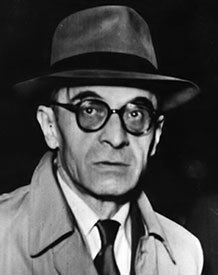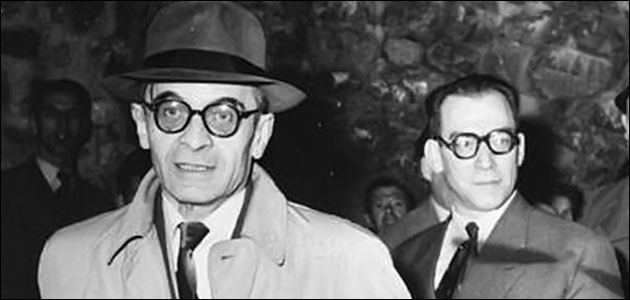Name Rudolf Roessler | ||
 | ||
Died December 11, 1958, Switzerland | ||
Rudolf roessler social studies lta
Early life

Rudolf Roessler was born on 22 November 1897 in Kaufbeuren, Bavaria. He was the son of a Bavarian Forestry Official. When World War I broke out, Rudolf Roessler enlisted in the army at the ripe age of 17. For four years, he served in the German army as a combat soldier. While in the army, he met ten men who would later become his contacts in World War II. After being released from service in the German army, he studied theology in Augsburg.
Contents
- Rudolf roessler social studies lta
- Early life
- His Contacts
- World War II
- Barbarossa
- Operation Zitadelle Citadelle
- After the War
- Trials
- Death and Quotes
- In Fiction
- References
When Adolf Hitler became prominent in German politics, Roessler and his ten contacts realized the dire danger and evil posed by this political leader. Rudolf Roessler started working as a newspaper man at the Augsburg Post Zeitung to wake fellow Germans to the rise of Nazism.
In 1933, Rudolf Roessler and his wife, Olga, had to flee to Lucern, Switzerland, with only 10 marks in his pocket(about $50). In Lucern, he opened a publishing house, the Vita Nova. There he wrote about the evils of Nazism under the name R.A. Hermes, after the Greek messenger god.
His Contacts
Unfortunately, due to the secrecy of Rudolf Roessler, not all of his contacts were ever disclosed. What we do know is they were all top German officials dedicated to the demise of Hitler. Of his ten contacts, five were generals. Their names were Helmuth S, Hermann F, Rudolf von Gersdorf, Fritz Thiele and Georg T. There was one colonel, "O", Major "K", and three Captains, "S", "A" and "O". These high German Officials had top spots in German Operations, Logistics, Transport, Military, Economy, and Communications. All 10 of the contacts survived through the various purges of Hitler.
World War II
One day, Rudolf Roessler was visited by German generals and two of his contacts, Rudolf von Gersdof and Fritz Thiele. He was given a radio and the nickname Lucy, short for Lucern where he lived. The one condition for his services was that he would never name his sources.
Roessler's information came straight from the German High command. He would get radio contact from the Official Broadcasting Center of the OberKommando de Wehrmadt. His contacts betrayed their country directly under the nose of Hitler himself. The information was given to a transmitter who only knew Roessler by his call number "RAHS." Any information regarding the German army was preceded by "Werther" and Air Force "Olga." His information contained troop movements, invasion timetables, production statistics, casualty counts, and loss of equipment for each battle. Often, his information was transmitted to the Russians before the German units received orders.
A typical day for Rudolf Roessler was: up at 6:30 and at 7:30 ride the trolley to work. By 8:00, the Vita Nova was open. Lunch was at noon. In the afternoon, he worked on Swiss intelligence. After dinner, he transmitted messages to the Russians. Rudolf Roessler never slept more than 3 hours a night.
The order of how the Russians received Roessler's information was this: the ten contacts would send information to Roessler. From Roessler, he would send to Christian Schneider his boss. From Schneider to Rado, then Foote, and finally to Moscow.
The amount of information Rudolf Roessler sent over the course of five years to Russia could fill about 40 average length books. That is about 5,500 messages or 5 messages a day for 3 years or even 129 messages a month. Russia used the information to create psychological warfare. This was an unqualified success, and many German soldiers suffered mental breakdowns as a result.
Barbarossa
Operation Barbarossa was the largest attack in history. On 3 August 1940, Hitler wanted to attack Russia. He planned on mobilizing armies for two offenses. In the north, the armies would head toward the Baltic States and Moscow. Then, Special Operations would secure the Baku Oil Fields. In the south, armies would attack Kiev and Dnieper. There would also be 650,000 men in Bulgaria to fight off the allies who would come to the aid of Russia. In total, the eastern front would have spanned over 1,000 miles. In this attack, there would be 186 total German divisions including 19 panzer units, 3,000,000 men, 750,000 horses, 600,000 cars, 7,200 guns, 3,000 tanks, and 1,800 planes.
Rudolf Roessler was able to get information for the complete order of battle including codenames, individual battalions down to the soldier, precise times and directions of attack, senior officers down the corps commanders, and the intention of each individual attack.
When Roessler received this information, he tried to give it to the Swiss to relay to the Russians, but the Swiss wouldn't share the information. Rudolf Roessler told them, "I must remember that my objective, and that of the men I represent, remains the death of Nazism. We are ready to help whoever will do the most to achieve that end, whatever their nationality." Through other contacts, Rudolf Roessler was able to contact the Russians. However, the Russian "center" believed Roessler to be an Agent Provocateur, or a double agent. The "Center" ignored Roessler's information. On 22 June 1941, Germany struck exactly as Roessler said. Because of this, Roessler was turned into a star intelligence agent. The center said, “From today all intelligence communication by Lucy will be classified as VYRDO(major importance) and be relayed immediately.”
Operation Zitadelle "Citadelle"
Operation Zitadelle was the greatest tank battle ever fought. Rudolf Roessler was able to get battle information for the sectors attacked, number of men and materials, where the supply and command posts were, where possible reinforcements could come from, and the day and hour of attack.
This time, Russia was prepared for the attack. 977,000 men, 3,300 tanks and assault guns, 20,000 other guns, and 3,000 aircraft in a defensive line 70 miles deep. The Soviets planned a counter-offensive trap which included a minefield to channel German tanks to 10 different antitank points with enough man power to completely destroy the target.
The German plan was simple, a classic pincer movement. The 9th army would come from the south with 13 divisions and 7 armored divisions. The 2nd Army would attack head on with 6 armored divisions, and 2 infantry divisions. Finally the 4th army would come from the north with 17 divisions, and 1 SS armored division. In total, the German army had 570,000 men, 2,500 tanks, and 2,000 aircraft.
It was called the greatest tank battle ever fought because of the number of tanks in that one battle. There were 850 Russian T-34s verses 600 of the 2nd SS Panzer division.
Operation Zitadelle was set for 5 July. By 13 July, the Germans retreated. The Panzer tank force never recovered, and the Germans would not go on the offensive on the Eastern Front again. The Germans suffered 30,000 losses, and 60,000 wounded in Operation Zitadelle. The Russian army suffered about the same. After this battle, Russia no longer needed Rudolf Roessler.
After the War
After the war, Rudolf Roessler became a freelance journalist. However, in the summer of 1947, due to financial difficulties, Roessler returned to espionage. He worked for the Czechoslovakian Government telling them about forces, disposition, and weapons of the United States, England, and France in West Germany, but this was very low level material.
Trials
Rudolf Roessler was arrested twice on counts of spying for a foreign nation. The first time was on 9 May 1944. Roessler was taken under heavy guard to the prison of Lausanne until he was released on 8 September 1944. The second time was in March 1953. He was put to trial on 2 November 1953. Roessler was charged with spying on the German Federal Republic for Czechoslovakia. He was imprisoned for 9 months and released in early 1954.
Death and Quotes
Rudolf Roessler died on 11 December 1958. Some people called Roessler a German Plant or a Russian spy. In reality, he was a dedicated anti-Nazi.
“Even more incredibly, he provided reports-which appeared to have been obtained right from Abwehr headquarters-on what the German intelligence service was telling Hitler about Russian positions, strength, and plans. Taken as a whole, it amounted to a breathtaking intelligence coup; the Russians not only were being told the precise strength and plans of their enemies, they also were learning the scope and accuracy of their opponent’s intelligence. Nothing like it had ever been seen before, nor has it been duplicated since.” Ernest Volkman
A British General said, "[Rudolf Roessler] Having contributed more to our victory in Europe than could have a dozen atom bombs."
Ronald Seth said, "Rudolf Roessler must be ranked among the greatest spies of all time."
"Rudolf Roessler was a saint." Joseph Stocker
In Fiction
Rudolf Roessler is a major character in Colin Forbes' thriller The Leader and the Damned. The book largely follows known historical facts in depicting Roessler getting messages from a highly-placed agent in Hitler's headquarters, giving exact and detailed information on the German army's dispositions on the Eastern Front and passing them on to Moscow, where they get the attention of Stalin in person. As depicted in the book, Roessler himself does not know the identity of this highly-placed agent, known only by the code-name "Woodpecker". Roessler has complicated relations with Brigadier Roger Masson, Head of Swiss Intelligence - who tolerates Roessler's espionage on condition that the Swiss get a copy of all messages. This is more than a bit risky for the Swiss - at a certain moment Walter Schellenberg of the SS Intelligence threatens an invasion of Switzerland by the German Army over this help to the Soviet espionage. Until the end Roessler never finds out the identity of "Woodpecker" - but the omniscient writer tells the reader that in fact it was none other than Martin Bormann. That, of course, is part of the fictional plot, for which there is no concrete historical evidence.
